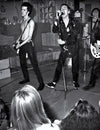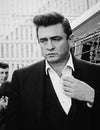
Nebraska - Bruce Springsteen's 6th album is a milestone like no other
After a gruelling 10-day drive from New Jersey to Los Angeles, Bruce Springsteen finally made an appointment with a psychiatrist, where he began chatting and eventually broke down in tears. At 32, years of repressed emotions burst forth in an uncontrollable outpouring. When he least expected it, the demons he'd been attempting to avoid caught up to him and came "spewing like an oil spill... [with the] black sludge threatening to smother" him.
In the midst of this, he wrote and produced his debut solo album, Nebraska, in 1982, a work of art bathed in the ooze of the muck that, he later revealed to biographer Dave Marsh, had left him feeling suicidal.
Things were not intended to go this way. After a year-long tour promoting the monumental double album The River, Springsteen's reputation as a world-class performer was secure, and his fame was only going to increase. It wasn't in the plan to release such a personal, acoustic-heavy solo album.
In addition, it was not done on purpose. On January 3, 1982, the New Jersey native set up in his bedroom in Colts Neck with a $1,050 Tascam 144 cassette recorder. He was under the impression that he was working on song ideas for a new E Street Band record. Out of the 15 tracks captured that night, 10 were used for Nebraska, and they were mostly left in their original, unrefined form with the exception of a few minor additions like harmonica or tambourine. For weeks, he carried that tape around in his pocket, never realising the immense value of the information it held.
A few months later, an attempt was made to record the entire band for "Electric Nebraska," but the re-recordings were unsuccessful because they lost the songs' ethereal, dreamlike feel in the process. Bruce Springsteen probably didn't realise it at the time, but whatever chance occurrence transpired as the new year extended into life that night would prove significant in the trajectory of his career. Nebraska was released on September 30, 1982, a week after his 33rd birthday, and it was the first time he didn't immediately go on the road to promote the album by playing it for anyone.
One humorous twist is that many of these songs have a protagonist driving a car. Looking for solace as the world speeds by, they observe the locals they come across on their journey.
The most lasting impressions, however, are contained in their accounts. We hear from murderers, regular folks, and low-level criminals, all of whom provide us a glimpse into their worlds through their accounts of bloodshed, hardship, and despair. There is no moralising in these songs, just individuals placed in hopeless situations. Their plights are grounded in humanity and are typically empathetic. Common people, pushed to the breaking point, have committed horrific things. Using simple, matter-of-fact language, they make their actions sound like something anybody could do if pushed too far. Some of the decisions they face along the way take on a much darker hue because of this.
Nebraska essentially emphasises the precariousness of the American dream and the importance of work, love, family, and friends in maintaining stability. This album explores the consequences of losing stability and having nowhere to turn for help. As evidence, consider the line "deliver me from nowhere" uttered by two characters in "State Trooper" and "Open All Night." Considering that awful things may only occur at night or early morning, it is only fitting that most of the action occurs at these times. However, even this minimal activity takes place in the voids. The words serve as signposts for the reader or listener. The true threat of the record lies in its silences and hints, when the listener is left to explore the album at his or her own risk.
According to Springsteen, he owes a tribute to the sprit of Bob Dylan, Hank Williams, the American gothic writing of Flannery O'Conner, and the "quiet violence" of Terrence Mallick's cinematic cosmos for the songs he wrote while in the thick of this melancholy fug.
The title tune, which was inspired by a recent watching of his 1973 film Badlands, heavily samples the latter. The true story of Charles Starkweather, 19, and his 14-year-old girlfriend Caril Ann Fugate, who went on a nationwide killing spree in 1958, is dramatised in both the song and the film. To set the tone for the rest of the album, Springsteen describes it as a song of "disconnection and isolation," singing from the perspective of the outlaw fresh off his first murder and culminating in a chilling depiction of capital punishment and the shrugged explanation that "there's just a meanness in this world."
The "honest man" of Atlantic City (the title was inspired by the Clint Eastwood film of the same name) succumbs to the temptation of organised crime when the weight of his mounting obligations becomes too much to bear. Mansion On The Hill is a real-life recollection from Springsteen's boyhood; it tells a story of the haves and the have-nots, with the symbolically unattainable haunting his nightmares despite the fact that he is now a man who resides in such a place. Johnny 99 encounters a recently fired autoworker pleading for the death penalty after being arrested for the murder of a night clerk. The breaking apart of a brotherhood is a major plot point in Highway Patrolman. In Used Cars, a child's perspective is used to explore themes of poverty, embarrassment, and frustration.
My Father's House, the second-to-last song, flips the script on the parable of the prodigal son. Reason To Believe is a sombre closing track that gives a nihilistic reflection on death, love, and religious initiation. After a disastrous wedding day, the story ends with the sardonic observation that "still, at the end of every hard-earned day people find some reason to believe."
Of course, this might be interpreted in a variety of ways. A more upbeat interpretation may see those final words as a beacon of hope in the midst of overwhelming despair. Nebraska is woven together by a thread of resiliency and human spirit, yet danger and simmering rage are the dominant themes. These songs seem like they came from out of a mind in complete disarray, which makes perfect sense. Because Nebraska is unflinching in its commitment to staring down the barrel of a gun. Its protagonists and antagonists are too far gone for their plights to be reduced to bumper sticker cliches. These are true accounts, and the truth can be brutal.
During this time, Springsteen also composed the initial Born In The USA demo. The songs for the album it would appear on two years later are sonically different from those on Nebraska, but they share a similar spirit because they were written around the same period and draw inspiration from the same wells. He would eventually give in to the pressures of superstardom, perform stadiums, and become an indispensible fixture on the pop charts because of those songs and that record.
In retrospect, he was no longer the painfully shy child who hid away in his room to practise guitar and find his voice. It's reasonable that he would change from the guy he was before he went to the psychiatrist to the person he became after finally speaking openly about his inner turmoil. For Bruce Springsteen, Nebraska is the watershed moment before the dam bursts and his life changes irrevocably.
























































